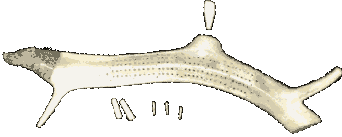
A Cribbage Board is a score keeping device used for playing a specific card game that is believed to have been first developed during the 17th century in England, and in modified form is still very popular throughout the world.
Purchased by the Museum in 1978 from an art gallery, this Cribbage Board was in a private collection and was later sold to the gallery. The sculptured board was created by Simanek, an Inuit artist who lives in Lake Harbour, on the southwest coast of Baffin Island (eastern Arctic). Carved to resemble a running animal, the head is made of green soapstone, while the body is composed of a caribou antler. The entire sculpture is 39cm long x 4cm wide x 4.5cm high. The soapstone head is glued to the antler. The sides of the antler have been drilled with rows of holes so that it may be used as a Cribbage Board. A protrusion on one side of the antler has been carved out to serve as receptacle for keeping five score keeping pegs (approximately .2cm diameter x 1.7cm long). A flat, tapered bone (3.5cm long x 1.5cm wide x 1cm thick) has been carved to fit into the protrusion so the pegs don't fall out when stored inside.
There is a long history of Inuit artistry with respect to carved ornamentation fashioned into figurines representing animals - as exemplified in this Cribbage Board. However, after contact with European and North American traders in the 18th century, carvings such as this Cribbage Board were produced primarily for trade purposes and not for Inuit use. Indeed, the game of Cribbage is not an indigenous Inuit game. Encouraged by the Canadian government, sculpture and print making of traditional Inuit culture has become a mainstay of the Inuit economy in the 20th century.
Last update June 20, 2010